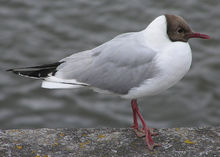September 20, 2009
How do we name Influenza A?
Where do the name H1N1 and all the other names come from? What determines the number of H and N?
![]() Established by WHO in1980 [1], the nomenclature of Influenza A consists of: type of host, in case the virus has not been isolated from humans; geographical region of origin; number of lineage; year of isolation and; protein antigen type, described by letter and number, H1 to H16 known to date, and N1 to N9. The current pandemic influenza, for example: A/California/04/2009(H1N1) Influenza type A, isolated firstly in California, lineage number 04, year of 2009 and type H1N1. In turn, the bird flu virus, which killed a child in 1997: A/Hong Kong/156/97 (H5N1), Influenza A, isolated in Hong Kong, lineage 156 of the year of 1997. One of the viruses closely related to it is the A/Turkey/England/91(H5N1) isolated in turkeys in England in 1991 [2]. In case of viruses isolated in places like lakes or seas without the identification of the animal carrier, the type of place is used instead of the species (e.g., A/lake water/Wisconsin/1/79).
Established by WHO in1980 [1], the nomenclature of Influenza A consists of: type of host, in case the virus has not been isolated from humans; geographical region of origin; number of lineage; year of isolation and; protein antigen type, described by letter and number, H1 to H16 known to date, and N1 to N9. The current pandemic influenza, for example: A/California/04/2009(H1N1) Influenza type A, isolated firstly in California, lineage number 04, year of 2009 and type H1N1. In turn, the bird flu virus, which killed a child in 1997: A/Hong Kong/156/97 (H5N1), Influenza A, isolated in Hong Kong, lineage 156 of the year of 1997. One of the viruses closely related to it is the A/Turkey/England/91(H5N1) isolated in turkeys in England in 1991 [2]. In case of viruses isolated in places like lakes or seas without the identification of the animal carrier, the type of place is used instead of the species (e.g., A/lake water/Wisconsin/1/79).
The main membrane proteins of Influenza, the Hemagglutinin and the Neuraminidase, are the first to be recognized by our immune system. The immune response tests (which will be explained and discussed on an upcoming text) were the first to be developed. The numbering is based on the recognition of HA and NA through antibodies. For example, when a new Neuraminidase was found in1957, which was not recognized by the antibodies for N1, it started to be called N2, the next after of N3, and so forth. There is some cross-reaction between the antibodies and some types of HA and NA, as the H7, that can be recognized by antibodies anti-H3 but this does not compromise the nomenclature system.
The numbering system HxNx was developed in a time period in which there was no availability of resources as the current sequencers of genetic material. Therefore, the typing based in antibodies was faster and simple and it provided a good view of what would be new or not. Although we have the impression that the viruses are similar because of the proximity of numbers, as H4 and H5, this does not implicate in any way some proximity of the virus but the discovery order. Thus, when it was discovered a new type of Hemagglutinin in seagulls of the species Larus ridibundus (image beside) collected in 1999 in Sweden, although it was more similar to H13, it was called H16 because it was known as 15 HA to date. The virus 2 isolated, for example, received the name of A/Black-headedGull/Sweden/2/99(H16N3) [3].
The two figures below were taken from a work of 2009, which classified many of the known sequences of Influenza A [4]. It refers to phylogenetic trees which group closer viruses with a more recent probable common origin, i.e., more similar viruses tend to stay closer to each other. The great diversity of H1-H3 and N1 and N2 is due to bigger abundance of samples from those viruses, since they are mainly around in humans and are much more sampled.
Note how H7 and H15 are similar, although their numbers are different. H13 and H16 are also similar.Note how N1 and N2 are much more sampled and are becoming different over time. Many of theses changes are a method for the virus not being recognized by our immune system and will be discussed on another text.
Sources:
[1] no authors (1980). A revision of the system of nomenclature for influenza viruses: a WHO memorandum. Bulletin of the World Health Organization, 58 (4), 585-91 PMID: 6969132
[2] Subbarao, K. (1998). Characterization of an Avian Influenza A (H5N1) Virus Isolated from a Child with a Fatal Respiratory Illness Science, 279 (5349), 393-396 DOI: 10.1126/science.279.5349.393
[3] Fouchier, R., Munster, V., Wallensten, A., Bestebroer, T., Herfst, S., Smith, D., Rimmelzwaan, G., Olsen, B., & Osterhaus, A. (2005). Characterization of a Novel Influenza A Virus Hemagglutinin Subtype (H16) Obtained from Black-Headed Gulls Journal of Virology, 79 (5), 2814-2822 DOI: 10.1128/JVI.79.5.2814-2822.2005
[4] Liu, S., Ji, K., Chen, J., Tai, D., Jiang, W., Hou, G., Chen, J., Li, J., & Huang, B. (2009). Panorama Phylogenetic Diversity and Distribution of Type A Influenza Virus PLoS ONE, 4 (3) DOI: 10.1371/journal.pone.0005022
No Comments » Posted in: Uncategorized



![Árvore filogenética de Hemaglutina, clique para ampliar. Fonte [4]](http://blog.h1n1.influenza.bvsalud.org/pt/files/2009/09/arvore_HA-275x300.png)
![Árvore filogenética de Neuraminidase, clique para ampliar. Fonte [4]](http://blog.h1n1.influenza.bvsalud.org/pt/files/2009/09/arvore_NA-279x300.png)